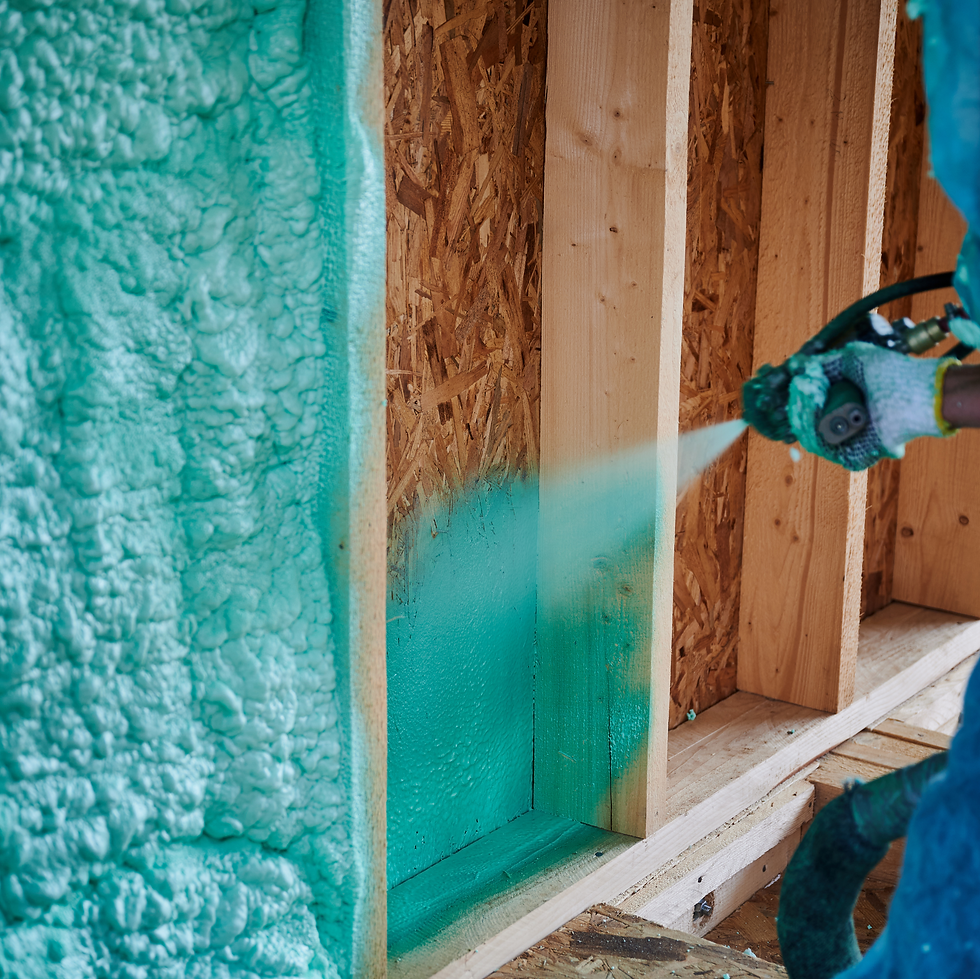Spray Foam Insulation & Sawdust: Why Carpenters Are Turning to Spray Foam for Long-Lasting Builds
- Innovative Insulation

- May 30
- 3 min read

Table of Contents:
The Overlap Between Craftsmanship & Insulation
Framing the Future: How Spray Foam Supports Structural Integrity
Sealing the Gaps: Why Air Barriers Matter in Carpentry
Moisture Management: Protecting Wood from the Inside Out
Reducing Callbacks & Keeping Clients Happy
Ideal Applications: Where Carpenters Can Use Spray Foam
Cost-Efficiency Over Time: Less Waste, Better Margins
Built to Last with Spray Foam and Wood
The Overlap Between Craftsmanship & Insulation
Carpentry is all about detail, durability, and pride in the work. Every joint, every cut — it all matters. But more and more carpenters are realizing something important: what you don’t see behind the walls matters just as much as the work you do. That’s where spray foam insulation comes in. Whether you're framing out a home, building a custom barn door, or working on a high-end cabin, spray foam is becoming a go-to material for carpenters who want their work to last and their clients to be thrilled for years to come.
Framing the Future: How Spray Foam Supports Structural Integrity
Here’s a cool thing most folks don’t know. Closed-cell spray foam actually strengthens the structure. Once it’s sprayed in, it hardens and sticks to studs, sheathing, and framing, almost like glue that locks everything together. That added rigidity helps resist movement, vibration, and shifting over time. If you're building in a windy area or on shifting soil, this can make a big difference in keeping walls plumb and stable. Unlike fiberglass, which just kind of flops into place, spray foam becomes part of the structure itself. That’s a win for both you and your clients.
Sealing the Gaps: Why Air Barriers Matter in Carpentry
Even the most skilled carpenter can’t avoid tiny gaps, whether it’s around framing, corners, or attic spaces. That’s just how buildings go together. But those little air leaks can cause big headaches down the road: cold spots, high utility bills, and unhappy customers.
Spray foam expands into every nook and cranny, creating an airtight seal that stops drafts and keeps the indoor climate comfortable. This is especially handy when you’re working on exposed beam designs or custom interiors where temperature consistency is key. Plus, it often eliminates the need for extra vapor barriers, which is one less step for you.
Moisture Management: Protecting Wood from the Inside Out
Wood and moisture? Not friends. Whether it’s humidity creeping into a crawlspace or condensation forming behind walls, moisture leads to mold, rot, and warped wood. The last thing any carpenter wants associated with their work.
Closed-cell spray foam acts like a moisture barrier, keeping dampness out and your wood protected. It’s especially helpful around subfloors, rooflines, and basement framing. Fewer issues mean fewer callbacks, and your reputation stays rock solid.
Reducing Callbacks & Keeping Clients Happy
Let’s face it — callbacks are a hassle. They eat up your time, cost money, and can dent your reputation if the client isn’t happy. Spray foam helps prevent a lot of those “after-the-fact” issues like drafts, sagging walls, or insulation that settles.
Clients love how much more comfortable their homes feel — and they’ll notice the energy savings too. Happy customers tell their friends, and that kind of word-of-mouth is marketing you can’t buy.
Ideal Applications: Where Carpenters Can Use Spray Foam
Spray foam isn’t just for attic spaces. Carpenters are using it all over the place:
Behind custom paneling and trim work
Inside post-and-beam and timber frames
Under subfloors or in basement walls
In tiny homes and modular builds
Around garages, workshops, or detached studios
Even in garden sheds or backyard ADUs
Its versatility and ability to mold into irregular spaces make it perfect for custom jobs, and we know how many of those you get.
Cost-Efficiency Over Time: Less Waste, Better Margins
Yes, spray foam costs more upfront than fiberglass or batt insulation. But over time? It pays for itself. Your clients will see energy bills drop — often by 20% to 50% — and you’ll have fewer warranty claims or fix-it visits. For carpenters, offering spray foam as an upgrade is a smart move. It adds value to your builds and gives your clients something premium they can feel good about investing in.
Built to Last with Spray Foam and Wood
At the end of the day, great carpentry is about building something that lasts — something you’d be proud to put your name on. Spray foam insulation is one of those behind-the-scenes tools that helps protect your craft, boost structural strength, and keep your clients happy long after the sawdust settles.
At Innovative Insulation, we work directly with carpenters, builders, and general contractors to make sure every job gets the right solution. Whether it’s a big build or a custom project, we’re here to help you build smarter. Give us a call at (845) 319-9169 or visit our website to request a free consultation.








Comments